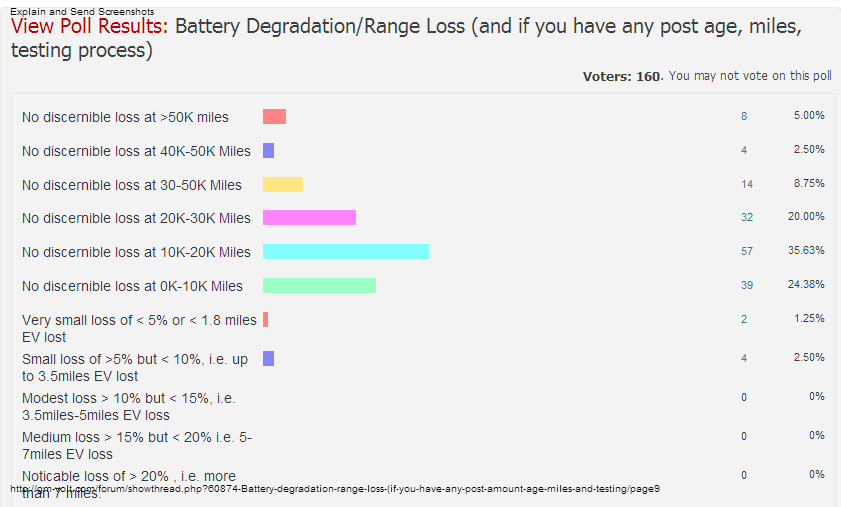RegGuheert
Well-known member
Thanks, Ed! Good find!edatoakrun said:I recall that the rate of Battery capacity loss and whether the Volt BMS would maintain Range by accessing a greater percentage of total capacity has been of interest to many.
There is a great deal of DOE test data on the Volt Available here:
http://avt.inel.gov/phev.shtml" onclick="window.open(this.href);return false;
You may want to look at the recent report below:
It is a very strange conclusion, given what I read in the report. They act as if the battery is only 2.2% below its rated capacity at the end of the test. By my reading, the battery is either 7%, 9% or 11% down at the end of the test. Take your pick! Should I believe Table 1, which contains a starting capacity well below the Volt batteries rated capacity and an ending capacity which is only slightly lower? Or should I believe Table 3, which contains a staring capacity closer to the rated capacity and a lower ending capacity, with the two numbers showing a more linear loss of capacity?edatoakrun said:2011 Chevrolet Volt VIN 0815 Plug-In Hybrid Electric Vehicle Battery Test Results
Tyler Gray
Jeffrey Wishart
Matthew Shirk
July 2013
The Idaho National Laboratory is a U.S. Department of Energy National Laboratory
Operated by Battelle Energy Alliance....
1.6 Conclusion
The testing of Chevrolet Volt 0815 included BOT and EOT battery tests and 14,836 miles of fleet testing in between. For vehicle battery packs, end-of-life (EOL) criteria is determined to be when the discharge capacity or discharge energy degradation exceeds 23% of the rated value, as specified in the USABC Electric Vehicle Battery Test Procedures Manual Rev 3 (publication pending). The Chevrolet Volt with VIN 0815 experienced a degradation of 2.2% in battery capacity. The battery of Chevrolet Volt 0815 is therefore well below the EOL threshold. The battery of Volt 0815 also had a degradation of 12.9% and 6.3% in discharge and charge power capability at 80% and 20% DOD, respectively, over the duration of 14,836 miles of fleet testing
http://avt.inel.gov/pdf/EREV/battery2011volt0815.pdf" onclick="window.open(this.href);return false;
In Table 3 we see that the battery started the test after the car had driven 8478 miles with 97% of its rated capacity of 16 kWh and ended the test after a total of 23,314 miles with only 89% of the rated capacity left. In other words, it lost 8% of the rated capacity in the 14,836 miles of this test and 11% of rated capacity since new (possibly more or less, since the battery was never tested new). The constant-power discharge used to determine the figures in Table 3 are very appropriate for EV application, IMO.
Sorry, but the numbers in Table 1 that are quoted in the conclusion make virtually no sense.
It seems clear the BMS is doling out capacity as the battery degrades, just as was originally reported. I will repeat that I think this is a very clever scheme.edatoakrun said:Not sure myself whether the relatively short time and low miles between the two tests allows definitive conclusions about the longer-term rate of Volt battery capacity degradation, but have any with much higher miles on their Volts seen any loss of range from new yet, as would seem likely by now if the percentage of available battery capacity percentage was being held constant by the Volt's BMS?
Like I said, the conclusion is weird. The important numbers to an owner are found in Table 3, IMO.edatoakrun said:Maybe some of the volt drivers or battery/power experts here here can explain the implications of the much larger percentages in the "degradation of...discharge and charge power capability" reported, and why the authors seem to find it significant enough to put it in the conclusion.
Entirely, methinks.edatoakrun said:Is that (entirely, largely, or partially?) due to the increased battery resistance (charts on p. 4) in Charge and discharge mode?
I think the Volt battery is doing roughly what everyone should expect: It is degrading with use. The numbers are decent for a battery that is 2/3 the capacity of what is included in the LEAF.edatoakrun said:What does that suggest about Volt battery/vehicle performance?
Good question.edatoakrun said:Is there a thread or threads on a volt forum where these DOE reports are being discussed?





